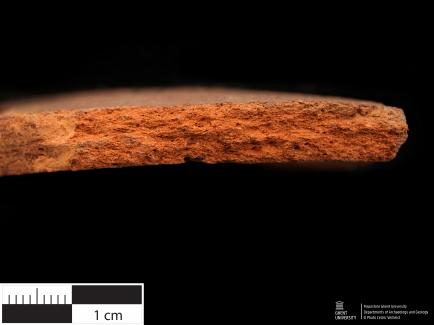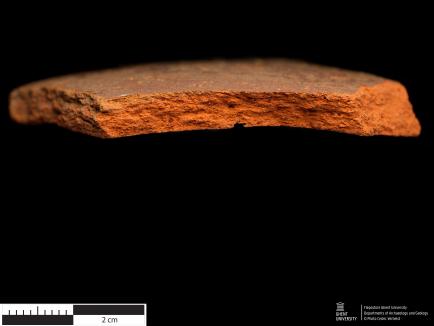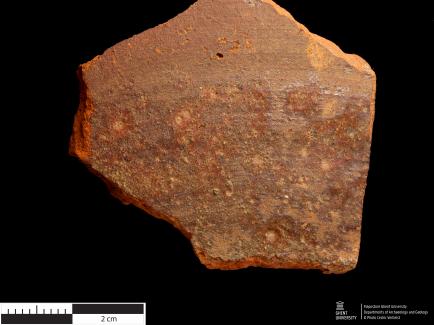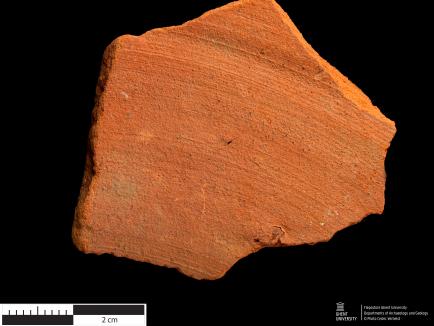Medieval - Red oxidized ware: lead glazed (6.ROLG.BE.0010)
Hand specimen pictures (macro & binocular)
Thin section pictures
Find location
- Category
- Red oxidized ware: lead glazed (Medieval)
- Fabric name
- Chronology
- Medieval > Late Medieval > 14-15th century CE
- Dating method(-s)
- typology, stratigraphy
- Potters' mark
- No
- Additional information
Find location
- Site type
- Pottery production
- Location
- Belgium; Vlaams-Brabant; Leuven
- Site name
- Leuven, Alfons Smetsplein
- Excavation or Survey Team
- Ruben Willaert bvba, Afdeling archeologie; J. De Gryse & J. Ooms
- Additional contextual information
- site code: LE-06-HPL; CAI code: 1999; feature S45, filling of the partially conserved kiln (filling with burned loam fragments, upper layer)
- Slip
- No
- Slip color
- Glaze
- Yes
- Glaze type
- lead glaze
- Glaze color
- orange
- Glaze additives
- Additional information
- splashed glaze
- Slip
- No
- Slip color
- Glaze
- No
- Glaze type
- Glaze color
- Glaze additives
- Additional information
- Surface color
- orange brown
- Surface texture
- Rough
- Fracture color
- orange
- Inclusions (non-plastics/tempering)
- quartz (rare grains up to 1 mm); rare red to dark brown inclusions (1-4 mm) (grog ?)
- Matrix and voids
- small vesicles
- Diagnostic features
- Additional information
- sample LE_HPL_ST1
- Flepostore inventory nr.
- ARCH1.L1.A21
- Original inventory nr.
- A0011
- Collection
- Archaeological Department, Ghent University
- Type
- Covered thin section
- Comparable thin section(s)
- Matrix
-
Oxidized red fabric; redbrown (PPL), dark brown (XP).
Semi-homgenous matrix, non-calcareous with low optical activity.
- ca. 40-60% - Inclusions
-
Quartz (++; mono, poly, cf: r, medium - coarse sand; ff: sr-sa, very fine to fine/medium sand; bimodal), sedimentary rock detritus (-; ff & cf, possible quartz arenite, sometimes slightly metamorfed), chert/flint (-; ff & cf), muscovite mica (+; el, ff & cf), feldspars (-; plagioclase, orthoclase: sr, ff & cf), glauconite (+; red in PPL, r, fine sand), pyroxene (--; r, ff), O/Fe (+; ff & cf), clay pellets/grog (-; unclear if grog or argillaceous inclusion).
The coarse fraction varies from coarse to medium sand, the fine fraction from fine sand to very fine sand. Coarse fraction grains are generally rounded, fine fraction grains are generally subrounded to subangular. Bimodality of all inclusions (natural). Overall the fabric is moderately to poorly sorted.
- ca. 40-50% - Voids
-
Small planar voids and larger vughs with good alignment parallel to the edge, no infill.
- ca. 10-20% - Diagnostic features
- The fabric is characterized by a semi-homogenous red-ox matrix with low optical activity and moderately high porosity. Dominant quartz inclusions with frequent muscovite mica, glauconite, opaques/iron oxides, few sedimentary rock detritus, chert/flintstone, feldspars, clay pellets/grog, and rare pyroxene. Bimodality most likely from sandy clay (no temper). Overall moderately to poorly sorted.
- Additional information
- Grog/argillaceous inclusion: oxidized, orange body color in PPL, dark yellow in XP, medium to high optical activity, very fine matrix (ca. 80-90%) with monocrystalline quartz (+; r-sr), muscovite mica (-; el), iron oxide (-); clear boundaries, rounded, neutral optical density, concordant features). Similar to inclusions in A0012.
- Sample type
- Pottery
- Inventory number
- 6.ROLG.BE.0010
- Collection
- Archaeological Department, Ghent University
- Donating institute/person
- Onroerend Erfgoeddepot Vlaams-Brabant-LOODS 68
- Host collection
- Onroerend Erfgoeddepot Vlaams-Brabant-LOODS 68
- Other samples available
- Yes
- Sample collection method
- Archaeological Excavation
De Gryse & Ooms 2007
- Full reference
-
De Gryse J. & Ooms J. 2007 Archeologisch onderzoek op het A. Smetsplein (Leuven). Onuitgegeven opgravingsverslag Ruben Willaert Bvba. Afdeling archeologie, Damme: 67.
Cite this page as: Flepostore - https://flepostore.ugent.be/ceramics/6-rolg-be-0010
Last modified: 2024-04-24.









